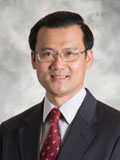A team of doctors from SGH and NUH are building the capability to provide these life-changing procedures in Singapore, tackling one challenge at a time.
Imagine the distress and social stigma faced by patients who have to live with severe facial disfigurement or amputated hands. With the aim of improving their patients’ quality of life, doctors at SGH are focusing their efforts on building capability and capacity for face and hand transplants – services not currently available in Singapore.
The team is led by Associate Professor Tan Bien-Keem, Head & Senior Consultant, Department of Plastic, Reconstructive & Aesthetic Surgery, and Dr Andrew Chin, Head & Senior Consultant, Department of Hand Surgery. A team at the National University Hospital (NUH) is working alongside the SGH team to introduce the procedures in Singapore.
Face and hand transplants are complex surgeries involving different types of tissues and dozens of connections to be made – skin, muscles, bones, tendons, blood vessels and nerves. However, Prof Tan noted, “They are no longer in the realm of experimental surgery. More than 20 face transplants and at least 60 hand transplants have been performed globally to date,” said Prof Tan.

Assoc Prof Tan Bien Keem
Head & Senior Consultant, Department of Plastic, Reconstructive & Aesthetic Surgery,
Singapore General Hospital
Although not life-saving procedures, hand and face transplants can make a profound difference in a patient’s life. Those who undergo hand transplants are able to resume sensation and function in their limb, unlike with prosthetics. Face transplant patients have been able to gain a sense of smell, and can smile, feel, eat and kiss.
"The first year of treatment will cost upwards of $500,000. The patient would also require lifetime follow up."
It will take time. More than just learning the surgical skills needed, the SGH team identified four challenges that they need to tackle in setting up a hand and face transplant programme in Singapore: finding a suitable patient, securing funding, reducing rejection rate of the transplant and creating social awareness.
Funding is needed as the first year of treatment will cost upwards of $500,000. The patient would also require lifetime follow up, which will add to the financial burden. The surgery team will have to undergo surgical training and mock operations, each lasting about seven hours.
Surgeons from the two hospitals have been meeting with Professors Kuo Yur-Ren (Kaohsiung, Taiwan) and Iyer Subramania (Kochi, India), clinicians who have successfully performed hand transplants in their countries.
"Creating social awareness and encouraging people to be donors is key."
The team is carrying out research on immunosuppression strategies based on the work of Prof Kuo. The goal is to determine the best intervention in times of transplant rejection.
Another research area they are working on is in chimerism, where donor and recipient cells can co-exist in the patient. When this is made possible, the patient no longer needs to undergo lifelong and costly anti-rejection treatment.
Away from the labs and operating theatre, creating social awareness and encouraging people to be donors is key.
“People have less emotional attachment to organs inside their bodies, so it’s easier to give them up for donation when they pass on, but hands and faces are different. Even if the donor gives their consent, their families may want to cremate or bury the body whole,” said Prof Tan.
He added, “We want people to see it a different way: that donating for transplants can provide the grieving family with meaningful closure, as it means giving a new lease of life to someone.”
